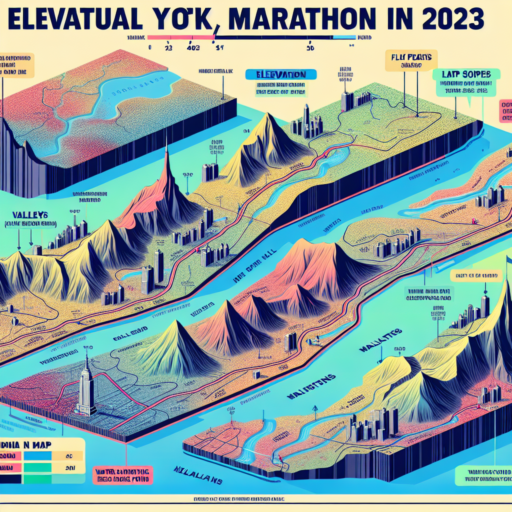Understanding the NYC Marathon 2023 Elevation Map
The NYC Marathon 2023 stands out as a beacon for long-distance runners worldwide, challenging participants with its dynamic and varied elevations. Comprehending the elevation map is vital for competitors aiming to optimize their training and race-day strategy. This elevation map, an essential tool for all participants, highlights the ascents and descents throughout the 26.2-mile course, providing a detailed insight into what runners can expect on the day of the marathon.
The map reveals several key segments with notable elevation changes. For instance, bridges often present the steepest inclines, requiring runners to summon extra strength and endurance. By studying these sections in advance, athletes can tailor their training to include hill runs, ensuring they’re adequately prepared for the race’s demands. Additionally, understanding the placement and severity of these inclines and declines enables runners to conserve energy, pacing themselves wisely to maintain stamina throughout the course.
Strategically, savvy runners will use the elevation map to plan their hydration and nutrition, as tackling steep elevations will undoubly increase their energy expenditure. Recognizing the less challenging sections can also help runners plan where they might recover and gather strength for the remaining miles. Thus, familiarity with the NYC Marathon’s topography, as detailed by the 2023 elevation map, is not just about physical preparation; it’s equally about mental preparedness and strategic planning.
Key Points in the NYC Marathon 2023: Elevation Challenges
The NYC Marathon is renowned not only for its vibrant atmosphere but also for the physical demands it places on runners. One of the most talked-about aspects of this marathon is its elevation challenges. These varied elevation points play a crucial role in testing the runners’ endurance and strategy.
The starting line on the Verrazzano-Narrows Bridge presents the first major elevation challenge. This bridge, connecting Staten Island and Brooklyn, offers a steep incline, setting a demanding pace right from the start. However, what goes up must come down, providing runners with a brief respite as they head into Brooklyn.
Another noteworthy challenge comes in the form of the Queensboro Bridge at approximately the 15-mile mark. Often referred to by runners as the «silent killer,» it lacks the cheering crowds found throughout much of the marathon route. The incline here is not just a physical hurdle; the absence of external motivation tests the mental resilience of the participants.
Finally, as the runners make their way into Central Park during the last few miles, they encounter rolling hills that, although not as steep as the previous challenges, demand every ounce of remaining energy. Central Park’s undulating terrain is a true test of a marathon runner’s tenacity, pushing them to maintain pace and strength when it matters most.
A Comprehensive Guide to the NYC Marathon 2023 Route and Its Elevations
The NYC Marathon 2023 is an eagerly anticipated event, drawing in runners from all around the globe. Understanding the route and its elevations is crucial for participants who aim to optimize their performance on race day. This guide provides an in-depth look into the course’s layout and the varying elevations that runners will encounter, offering invaluable insights for strategic planning.
The marathon kicks off on Staten Island, with competitors experiencing their first significant challenge in the form of the Verrazzano-Narrows Bridge. This early test offers initial elevations that can impact runners’ pace and energy management strategies. As participants move through the boroughs of Brooklyn, Queens, and the Bronx, they navigate a series of elevation changes—each adding a layer of complexity to the marathon’s already formidable distance. Being aware of these shifts is essential for maintaining a steady performance throughout the course.
One of the key aspects of successfully tackling the NYC Marathon is preparing for its final miles. After crossing into Manhattan via the Queensboro Bridge, participants face another substantial elevation increase. This portion of the race is notorious for its difficulty due to not only the physical challenge but also the timing within the marathon. Knowledge of this elevation profile allows runners to conserve energy earlier in the race, setting the stage for a strong finish through Central Park, where the route’s final undulations await.
How to Train for the NYC Marathon 2023: Tips Focused on Elevation
Preparing for the NYC Marathon requires not just dedication and hard work, but also a strategic approach to training, especially when it comes to handling the course’s varying elevations. The route’s undulating nature can be a challenging aspect for many runners. Incorporating elevation-specific training into your regimen can vastly improve your performance and overall experience during the marathon.
Incorporate Hill Workouts
One of the most effective ways to prepare for the elevations of the NYC Marathon is to incorporate hill workouts into your training plan. This involves running on inclines that mimic the marathon course. Start with smaller hills and gradually increase the difficulty level to build your stamina and strength. Hill repeats, where you run up a hill at a challenging pace, then jog or walk down to recover, are particularly beneficial. Aim to include hill workouts at least once a week to acclimate your body to the demands of the NYC Marathon’s elevation changes.
Strength Training for Elevation
Strength training plays a critical role in preparing your body for the unique challenges posed by the NYC Marathon’s elevations. Focus on exercises that strengthen your core, glutes, calves, and quads, as these muscles are vital for uphill and downhill running. Exercises like squats, lunges, calf raises, and planks can significantly enhance your ability to tackle the various elevations you will encounter. Incorporating two to three strength training sessions per week can make a substantial difference in your ability to manage the marathon’s elevation variations with greater ease.
Embracing elevation-focused training techniques ensures you are not only prepared for the flat portions of the NYC Marathon but are also well-equipped to handle the hills and slopes with confidence. Whether it’s through hill workouts or targeted strength training, focusing on elevation will better prepare you for the demands of the NYC Marathon 2023, leading to an improved performance and overall marathon experience.
Elevation Overview: What to Expect During the NYC Marathon 2023
The New York City Marathon is a beacon for runners worldwide, drawing thousands of participants each year. A crucial aspect that impacts every runner’s experience is the race’s elevation profile. Understanding the elevation changes and how they unfold along the course is vital for both first-time participants and seasoned marathoners aiming for a personal best in 2023.
The race begins on Staten Island with one of its most challenging features: the Verrazzano-Narrows Bridge. This initial ascent sets a demanding tone for the miles ahead. However, what goes up must come down, offering runners a brief respite as they descend into Brooklyn. The course through Brooklyn is relatively flat and fast, allowing runners to find their rhythm and pace during the early stages of the marathon.
As participants progress into Queens and then Manhattan, they encounter a series of gradual inclines and declines. The Queensboro Bridge, just past the halfway point, represents another significant elevation challenge. This often comes at a crucial moment when runners are assessing their energy reserves for the second half of the race. Finally, Central Park awaits as the last battleground with its rolling hills, particularly the inclines near the end of the race, testing the resilience and stamina of all participants as they push towards the finish line.
Analyzing the Most Challenging Elevations in the NYC Marathon 2023
The NYC Marathon stands as a testament to the human spirit’s resilience and determination. Within its sprawling 26.2-mile journey, runners face a variety of challenges, not least of which are the daunting elevations that dot the course. These elevations are not merely physical obstacles; they represent critical mental hurdles that can define the marathon experience. In this analysis, we delve into the most challenging elevations in the NYC Marathon 2023, offering insights into what makes these particular stretches so daunting.
The Verrazzano-Narrows Bridge: The Starting Point
At the very outset of the marathon, runners are greeted by the imposing ascent of the Verrazzano-Narrows Bridge. Spanning approximately 2 miles, this bridge is not only a significant physical barrier due to its steep incline but also a psychological one as it represents the first major challenge of the race. The climb tests the runners’ early pacing strategies and sets the tone for the miles to come. The descent, while offering some respite, poses its own set of challenges, requiring careful management of pace to prevent early fatigue.
The Queensboro Bridge: The Mid-Race Monster
Moving deeper into the marathon, the Queensboro Bridge emerges as a formidable challenge. Often referred to as the «Mid-Race Monster,» this stretch presents a steep incline over 1.5 miles without the encouragement of spectator support, making it a lonely and daunting path. The bridge’s elevation not only demands significant energy expenditure but also mental fortitude, as runners must conquer this beast to reach the euphoria of descending into Manhattan’s cheering crowds.
Understanding these elevations is crucial for athletes preparing for the NYC Marathon. By acknowledging the physical and mental demands of these stretches, runners can tailor their training to better manage these hurdles, ultimately leading to a more successful and fulfilling marathon experience. The crux of the challenge lies not in any single elevation but in the cumulative toll they exact, underscoring the importance of comprehensive preparation and strategy.
Preparation Strategies for High-Elevation Points in NYC Marathon 2023
Preparing for the New York City Marathon involves comprehensive training plans that address both the physical and mental challenges posed by the course. Among the key elements that runners need to focus on are the high-elevation points scattered throughout the marathon route. These elevated areas can test your endurance, slow your pace, and demand more from your energy reserves than flatter segments. Therefore, implementing specific Preparation Strategies for High-Elevation Points in the NYC Marathon 2023 is crucial for a successful race day.
Understanding the Elevation Profile
Firstly, familiarizing yourself with the marathon’s elevation profile is essential. Knowing where these high points occur enables you to tailor your training to mimic similar conditions. Incorporating hill repeats and long runs that feature significant inclines can improve your muscle strength and cardiovascular endurance. Additionally, practicing on hills teaches your body to conserve energy, allowing you to tackle the ascents efficiently during the marathon. This strategy not only prepares you physically but also boosts your confidence, knowing that you’ve trained in conditions akin to the race course.
Adjusting Your Pace and Breathing
Adjusting your pacing strategy is critical when approaching high-elevation points. A common mistake runners make is maintaining a constant pace throughout the race, regardless of elevation changes. Instead, focus on maintaining a consistent effort, which may mean slowing your pace as you ascend. Matching your effort to the terrain helps in conserving energy, which is vital for the latter stages of the marathon. Equally important is mastering your breathing technique. Deep, rhythmic breathing can help manage the increased physical demand during elevation gain, ensuring a steady supply of oxygen to your muscles.
No se han encontrado productos.
NYC Marathon 2023: Understanding the Impact of Elevation on Your Run
The NYC Marathon is an iconic event that attracts runners from all around the world, presenting a unique challenge that goes beyond the physical endurance of covering 26.2 miles. One significant factor that affects a runner’s performance, and which is often underestimated, is the elevation profile of the course. Knowing the elevation changes and understanding their impact is crucial for effective race preparation and strategy.
The Elevation Challenge of the NYC Marathon
Although not known for extreme elevations, the NYC Marathon course does feature several key points where elevation could impact your run. These include bridges and rolling hills that test your stamina and strategy. For instance, the Verrazzano-Narrows Bridge at the start presents an initial uphill challenge, followed by a downhill stretch. Similarly, the Queensboro Bridge at the halfway point offers a lengthy incline that can affect pacing. Acknowledging these elevation points allows runners to adjust their training to include hill repeats and strength workouts, thereby minimizing surprises on race day.
Strategies to Tackle Elevation Changes
- Maintain even effort: Instead of trying to maintain a steady pace, aim for an even effort. Your pace might slow down on uphills but compensating on downhills can balance your overall effort.
- Train on similar terrain: Incorporate running routes in your training that mimic the elevation changes of the NYC Marathon. This will help your body adapt and improve your resilience on race day.
- Focus on form: Uphills and downhills require adjustments in your running form. Lean slightly forward when ascending and use gravity to your advantage on descents, keeping your steps light and controlled.
Understanding and preparing for the elevation dynamics of the NYC Marathon can markedly improve your race experience. Adopting specific training strategies and mentally preparing for these challenges ensures you not only finish but also enjoy the journey through the five boroughs.
Interactive Elevation Map for the NYC Marathon 2023: How to Use It to Your Advantage
When preparing for the iconic NYC Marathon 2023, understanding the route’s elevations through an interactive elevation map can be a game-changer for your training and race strategy. This comprehensive tool not only provides invaluable insights into the highs and lows of the marathon’s course but also empowers you to tailor your training sessions to mimic these conditions closely. By familiarizing yourself with the elevation changes, you are essentially giving yourself a sneak peek into the challenges ahead, allowing for a more focused and effective preparation.
The interactive elevation map for the NYC Marathon 2023 offers real-time elevation data and detailed views of every uphill and downhill segment along the 26.2-mile course. This knowledge enables runners to fine-tune their pacing strategy, ensuring they conserve energy on tough inclines and capitalize on the less demanding declines. Moreover, the map’s interactive nature allows users to zoom in on specific areas for a closer look at precise elevation levels, turning preparation into a strategic advantage on race day.
Benefitting from this innovative tool involves not only studying the map but also incorporating elevation-specific workouts into your training regime. By simulating the course’s challenges, such as the notorious Verrazzano-Narrows Bridge at the start or the series of hills in the final miles, you can develop muscle memory and mental resilience that will serve you well on marathon day. Additionally, understanding where the course levels out offers the perfect opportunity to strategize for recovery and hydration points, ensuring you stay strong throughout the race.
Historical Elevation Changes and Their Impact on Past NYC Marathons: A Look into 2023
The New York City Marathon stands as a testament to human endurance, pushing runners to their limits across a challenging course that spans the five boroughs. However, a significant, often underappreciated factor that impacts performance and strategy is the elevation changes throughout the marathon’s historical route. As we approach the 2023 NYC Marathon, it’s crucial to understand how these elevation shifts have influenced past events and what runners might expect this year.
Elevation changes in the NYC Marathon vary, starting from the Verrazzano-Narrows Bridge—the marathon’s highest point—to the more level stretches along First Avenue. Yet, it’s the bridges, including the Queensboro and Pulaski, that introduce the most challenging elevation adjustments. These shifts not only test the runners’ stamina but also their pacing strategy. Over the years, elite runners have had to adapt their training to tackle these inclines efficiently, whereas casual participants often find these parts of the course particularly daunting.
In the lead-up to the 2023 NYC Marathon, analyzing the impact of historical elevation changes is vital for both new entrants and seasoned marathoners. Preparation for these elevation shifts can be the difference between achieving a personal best or hitting ‘the wall.’ As such, structured hill training, familiarity with the course’s profile, and strategic energy preservation will be crucial components of a successful race plan.




